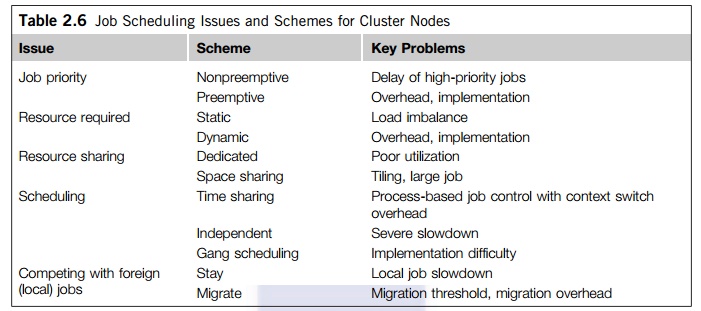Chapter: Distributed and Cloud Computing: From Parallel Processing to the Internet of Things : Computer Clusters for Scalable Parallel Computing
Cluster Job Scheduling Methods
Cluster Job Scheduling Methods
Cluster jobs may be scheduled to run at a specific time (calendar scheduling) or when a particular event happens (event scheduling). Table 2.6 summarizes various schemes to resolve job scheduling issues on a cluster. Jobs are scheduled according to priorities based on submission time, resource nodes, execution time, memory, disk, job type, and user identity. With static priority, jobs are assigned priorities according to a predetermined, fixed scheme. A simple scheme is to schedule jobs in a first-come, first-serve fashion. Another scheme is to assign different priorities to users. With dynamic priority, the priority of a job may change over time.
Three schemes are used to share cluster nodes. In the dedicated mode, only one job runs in the clus-ter at a time, and at most, one process of the job is assigned to a node at a time. The single job runs until completion before it releases the cluster to run other jobs. Note that even in the dedicated mode, some nodes may be reserved for system use and not be open to the user job. Other than that, all cluster resources are devoted to run a single job. This may lead to poor system utilization. The job resource

requirement can be static or dynamic. Static scheme fixes the number of nodes for a single job for its entire period. Static scheme may underutilize the cluster resource. It cannot handle the situation when the needed nodes become unavailable, such as when the workstation owner shuts down the machine.
Dynamic resource allows a job to acquire or release nodes during execution. However, it is much more difficult to implement, requiring cooperation between a running job and the Java Mes-sage Service (JMS). The jobs make asynchronous requests to the JMS to add/delete resources. The JMS needs to notify the job when resources become available. The synchrony means that a job should not be delayed (blocked) by the request/notification. Cooperation between jobs and the JMS requires modification of the programming languages/libraries. A primitive mechanism for such cooperation exists in PVM and MPI.
1. Space Sharing
A common scheme is to assign higher priorities to short, interactive jobs in daytime and during evening hours using tiling. In this space-sharing mode, multiple jobs can run on disjointed partitions (groups) of nodes simultaneously. At most, one process is assigned to a node at a time. Although a partition of nodes is dedicated to a job, the interconnect and the I/O subsystem may be shared by all jobs. Space sharing must solve the tiling problem and the large-job problem.
Example 2.12 Job Scheduling by Tiling over Cluster Nodes
Figure 2.22 illustrates the tiling technique. In Part (a), the JMS schedules four jobs in a first-come first-serve fashion on four nodes. Jobs 1 and 2 are small and thus assigned to nodes 1 and 2. Jobs 3 and 4 are parallel; each needs three nodes. When job 3 comes, it cannot run immediately. It must wait until job 2 finishes to free up the needed nodes. Tiling will increase the utilization of the nodes as shown in Figure 2.22(b). The overall execution time of the four jobs is reduced after repacking the jobs over the available nodes. This pro-blem cannot be solved in dedicated or space-sharing modes. However, it can be alleviated by timesharing.

2. Time Sharing
In the dedicated or space-sharing model, only one user process is allocated to a node. However, the sys-tem processes or daemons are still running on the same node. In the time-sharing mode, multiple user pro-cesses are assigned to the same node. Time sharing introduces the following parallel scheduling policies:
1. Independent scheduling The most straightforward implementation of time sharing is to use the operating system of each cluster node to schedule different processes as in a traditional workstation. This is called local scheduling or independent scheduling. However, the performance of parallel jobs could be significantly degraded. Processes of a parallel job need to interact. For instance, when one process wants to barrier-synchronize with another, the latter may be scheduled out. So the first process has to wait. As the second process is rescheduled, the first process may be swapped out.
2. Gang scheduling The gang scheduling scheme schedules all processes of a parallel job together. When one process is active, all processes are active. The cluster nodes are not perfectly clock-synchronized. In fact, most clusters are asynchronous systems, and are not driven by the same clock. Although we say, “All processes are scheduled to run at the same time,” they do not start exactly at the same time. Gang-scheduling skew is the maximum difference between the time the first process starts and the time the last process starts. The execution time of a parallel job increases as the gang-scheduling skew becomes larger, leading to longer execution time. We should use a homogeneous cluster, where gang scheduling is more effective. However, gang scheduling is not yet realized in most clusters, because of implementation difficulties.
3. Competition with foreign (local) jobs Scheduling becomes more complicated when both cluster jobs and local jobs are running. Local jobs should have priority over cluster jobs. With one keystroke, the owner wants command of all workstation resources. There are basically two ways to deal with this situation: The cluster job can either stay in the workstation node or migrate to another idle node. A stay scheme has the advantage of avoiding migration cost. The cluster process can be run at the lowest priority. The workstation’s cycles can be divided into three portions, for kernel processes, local processes, and cluster processes. However, to stay slows down both the local and the cluster jobs, especially when the cluster job is a load-balanced parallel job that needs frequent synchronization and communication. This leads to the migration approach to flow the jobs around available nodes, mainly for balancing the workload.
Related Topics